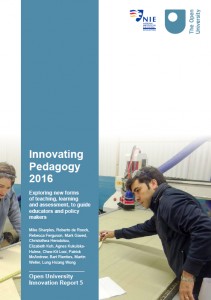Back in July 2012 I wrote a post about a new publication from the UKOU, Innovating Pedagogy. The plan was to make it an annual publication, and they haven’t failed yet (though sometimes it’s a bit late, especially the 2014 edition). Innovating Pedagogy 2016 has now been released.
The aim remains essentially the same, to explore “new forms of teaching, learning and assessment for an interactive world, to guide teachers and policy makers in productive innovation.” As usual, the focus is on ten emerging innovations, and this time, as with the last couple, the OUHK core group (in particular, Mike Sharples and Martin Weller) has teamed up with another institution, in this case the Learning Sciences Lab at the National Institute of Education in Singapore. As with previous reports, some of the innovations are recognisably updated versions of older ideas, often given impetus through the application of new technologies.
For 2016, the ten that made the final list after sifting are:
- Learning through social media: that is, using social media to offer “a range of learning opportunities, to access expert advice, encounter challenges, defend opinions and amend ideas in the face of criticism”.
- Productive failure: “a method of teaching that gives students complex problems to solve and attempt to form their own solutions before receiving direct instruction.”
- Teachback: here the focus is on the learner attempting to explain (or teach back) what they’ve learned from a teacher, fellow student or learning resource.
- Design thinking: learners solve “problems using the methods and thinking processes used by designers.”
- Learning from the crowd: “Amateurs and experts exchange ideas, generate and discuss content, solve problems, vote for the best solutions, and raise funds.”
- Learning through video games: no explanation needed!
- Formative analytics: in contrast to summative learning analytics, formative analytics “support learners to reflect on what they have learned, what can be improved, which goals can be achieved, and how they should move forward.”
- Learning for the future: Learners “should acquire skills and dispositions that will enable them to cope with an uncertain life and a complex work environment.”
- Translanguaging: this refers to learners’ ability to move “flexibly and fluidly between languages.”
- Blockchain for learning: This takes a bit of explaining. “A blockchain stores digital events securely on every user’s computer rather than in a central database. … Blockchain learning explores how this approach could be applied to education, shifting from central records of student performance held by schools and universities to a more democratic model in which achievements are recorded by a wider range of participants.”
I was very pleased to see number 4 with its focus on design. It’s a topic I’ve written about before, particularly in ‘Is Instructional design Truly a Design Activity?‘ Coincidentally, the discussion relies on the same excellent publication on which I based my article. It’s by Bryan Lawson (How Designers Think), who articulated a framework for the design process that has clear application in education.
Watch out for number 7, formative analytics, as it will likely have a major impact on learning. The key innovation is that it is all about analytics for learning rather than analytics of learning. As the authors explain, “formative analytics are focussed on supporting the learner to reflect on what has been learned, what can be improved, which goals can be achieved, and how to move forward. By providing analytics for learning rather than analytics of learning, formative analytics aim to empower each individual learner to reach his or her potential through real-time personalised automated feedback and visualisations of potential learning paths.”
If on the remote possibility that none of the ten particularly excite you, at least read the introduction, as it provides an excellent outline of where we are and where we’re heading.
